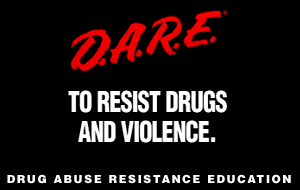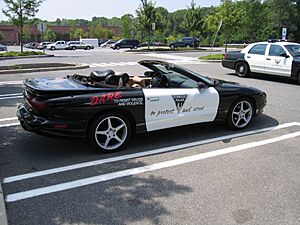Drug Abuse Resistance Education facts for kids
Drug Abuse Resistance Education, better known as D.A.R.E., is a program that teaches students how to avoid making unhealthy choices. It focuses on saying no to harmful substances, gangs, and violent behavior. The program started in Los Angeles in 1983. It was a team effort between the LAPD police department and the Los Angeles Unified School District.
D.A.R.E. became very popular in the 1980s and 1990s. At its peak, the program was taught in 75% of American schools. The main idea was to have police officers visit classrooms. They would teach kids about the dangers of harmful substances and how to say "no" if someone pressured them. The program also talked about avoiding things like tobacco and graffiti.
However, in the 1990s and 2000s, studies were done to see if D.A.R.E. was actually working. Some of these studies suggested the program wasn't as effective as people hoped. Some even said it might not be helpful at all. Despite these studies, many people and politicians continued to support D.A.R.E. for a long time. Eventually, the government greatly reduced the money given to the program.
D.A.R.E. was famous for its T-shirts and other items with its logo. The program's mascot is a friendly character named Daren the Lion. The American headquarters for D.A.R.E. is in Inglewood, California. The program also expanded to other countries, like the United Kingdom in 1995.
Contents
History of the D.A.R.E. Program
The D.A.R.E. program began in 1983. Its goal was to teach elementary school students how to resist peer pressure. This meant giving them the skills to say no to tobacco and other harmful things. The program was created by Daryl Gates, the police chief of Los Angeles, and Harry Handler, a leader in the city's school district.
What started as a local program in Los Angeles quickly grew. By the late 1980s, it was known all across the United States. In 1988, President Ronald Reagan even announced the first National D.A.R.E. Day. At its most popular, D.A.R.E. was in three out of every four school districts in the country.
What Was Taught in D.A.R.E. Classes?
Police officers in uniform would visit schools to teach the D.A.R.E. lessons. They talked about the negative effects of making poor choices. They also taught students how to build their self-esteem and find support from friends and family. The lessons encouraged students to find positive alternatives to unhealthy activities.
The lessons were designed to be taught by police officers, not regular teachers. Officers were also encouraged to spend casual time with students. They might play basketball during recess or chat with students at lunch. Sometimes, officers would arrive in cool sports cars that had been taken from people who broke the law. This was meant to show that making bad choices could lead to losing things you care about.
Changes to the Program
Starting in the 1990s, researchers began to study how well D.A.R.E. worked. Many studies found that the program didn't really change whether students made unhealthy choices later on. One report in 2003 found "no significant differences" in behavior between students who took D.A.R.E. and those who didn't. Because of these findings, the program lost a lot of its funding.
After many years of criticism, the D.A.R.E. curriculum was updated in 2009. The new program is called "Keepin' it REAL." It focuses more on interactive activities and role-playing instead of just lectures. The goal is now broader, aiming to teach students good decision-making skills for all parts of life.
Studies on D.A.R.E.'s Effectiveness
Over the years, many researchers have studied the D.A.R.E. program to see if it was successful. These studies looked at whether students who took D.A.R.E. were less likely to make unhealthy choices than students who didn't.
Early Studies in the 1990s
- 1992 – Indiana University: Researchers studied students in Indiana. They found that students who went through the D.A.R.E. program had higher rates of certain behaviors later on.
- 1994 – RTI International: Scientists reviewed eight different studies on D.A.R.E. They concluded that the program taught students a lot of information. However, it had very little effect on their actual choices. They also found that smaller, more interactive programs worked better.
- 1995 – California Department of Education: A report in California stated that D.A.R.E. and other similar programs in the state were not working. It found that as students got older, they were less influenced by these programs.
Later Research
- 1999 – Ten-Year Study: A study followed about one thousand students for ten years after they graduated from D.A.R.E. When the students were 20 years old, researchers compared them to students who had not taken D.A.R.E. They found no real difference in their behaviors.
- 2001 – U.S. Surgeon General: The Surgeon General of the United States, the nation's top doctor, listed D.A.R.E. as an "Ineffective" program.
- 2007 – Perspectives on Psychological Science: A science journal included D.A.R.E. on a list of programs that could potentially have a negative effect.
Because of these and other studies, the U.S. government stopped allowing its money to be used for programs that couldn't prove they were effective. This led D.A.R.E. to completely change its curriculum in 2009 to the new "Keepin' it REAL" model.



